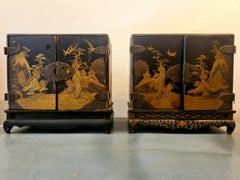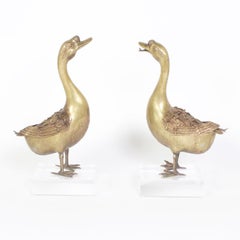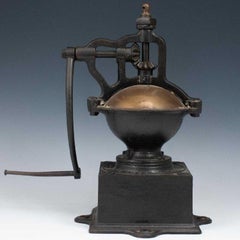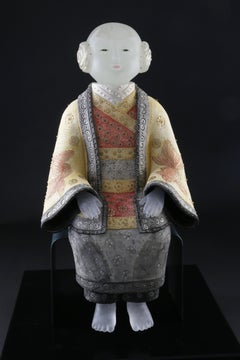Edo Sculptures
to
1
1
1
1
Overall Width
to
Overall Height
to
1
2
1
10,355
3,608
1,556
1,009
452
168
137
130
82
81
62
28
9
6
1
1
1
1
1
1
2
1
1
1
1
2
1
Style: Edo
Pair Japanese Lacquered Maki-e Meiji Period Cabinets 漆器 蒔絵 塗物 漆塗
Located in Cotignac, FR
A pair of Meiji period, late 19th Century Lacquerware (漆器, shikki) miniature cabinets on stands. The decorative panels are of very fine quality. The cabinets are a 'true pair' that i...
Category
Late 19th Century Edo Sculptures
Materials
Wood, Lacquer
$2,289 Sale Price
20% Off
Pair of Bronze Geese Sculptures
Located in Palm Beach, FL
Important pair of Japanese bronze birds in the form of geese masterfully crafted. One with a closed beak the other open, both with quirky expressi...
Category
Late 19th Century Edo Sculptures
Materials
Bronze
Buddhist Monk Antique Asian Wood Sculpture
Located in Lake Worth Beach, FL
Buddhist Monk Antique Asian Wood Carving
18Th Century or earlier possibly Japanese wood sculpture of a Buddhist Monk resting on lotus blossom on newer...
Category
18th Century Edo Sculptures
Materials
Wood, Paint
Related Items
Polo Player Bookends in Bronze
Located in Brookville, NY
Polo Bookends in bronze for the sporty library. These were purchased from the collection of a polo player on Long Island who had a beautiful library of sporting books. He also owne...
Category
1960s Edo Sculptures
Materials
Bronze
Antique, 19th C. Peugeot Frères Brevetés French Coffee Grinder Table Sculpture
Located in Surfside, FL
This is being sold as a piece of (functional?) decorator table sculpture for a kitchen or restaurant. I do not know if or how it works. the wheel and gears turn. It might be missing a cover on the handle. It is a lovely antique piece. Made in France.
A halfcentury before they produced their first car, the Peugeot brothers were making coffee grinders, continuing to do so for over 100years. In 1840 the Peugeots produced their first moulin a
cafe out of a combination of metal and wood. The beans were inserted into the metal
hopper up top; metal gears were turned by a woodenknob-capped metal...
Category
Late 19th Century Edo Sculptures
Materials
Metal, Brass
$850
H 14.5 in W 14 in D 8.5 in
"LOVE in the Streets" Wall Sculpture 24" x 48" x 1" inch by Shawn Kolodny
Located in Culver City, CA
"LOVE in the Streets" Wall Sculpture 24" x 48" x 1" inch by Shawn Kolodny
Resin, Wood, Acrylic paint
Creating art to reflect the times we live in...
Category
21st Century and Contemporary Edo Sculptures
Materials
Resin, Wood, Acrylic
$3,900
H 24 in W 48 in D 1 in
Mujer Agachada (Crouching Woman), 1972, (III/VI)
Located in San Francisco, CA
Felipe Castañeda
Mujer Agachada (Crouching Woman), 1972
Bronze, wood base
12 x 9.5 x 11.5 inches
Edition III/VI
Most recent owners acquired this limited-edition bronze sculpture fro...
Category
Late 20th Century Edo Sculptures
Materials
Bronze
$15,000
H 12 in W 9.5 in D 11.5 in
'Pumpkin' Set of Two, Pop Art Resin Sculptures, 2016
By Yayoi Kusama
Located in New York, NY
The ’Pumpkin' Set of Two sculptures are polka-dotted painted lacquer resin collectible art objects by the legendary contemporary Artist, Yayoi Kusama. Published by Benesse Holdings, ...
Category
2010s Edo Sculptures
Materials
Resin, Epoxy Resin, Lacquer, Acrylic
$2,108 Sale Price
20% Off
H 3.75 in W 7 in D 3.5 in
Woman Lying Down & Growing with Tree bronze sculpture by Yulla Lipchitz
Located in Hudson, NY
Organic, abstract bronze sculpture by Yulla Lipchitz of a woman lying down with a tree.
About this artist: Yulla Lipchitz, née Halberstadt, was born on April 21, 1911 in Berlin, Ge...
Category
1970s Edo Sculptures
Materials
Bronze
$3,775
H 16 in W 7 in D 8 in
Joel Urruty - Wesson, Sculpture 2024
By Joel Urruty
Located in Greenwich, CT
Medium: Bleached and Lacquered Basswood
As an artist I strive to create elegant sculptures that capture the true essence of the subject matter. Form, line and surface are used as th...
Category
2010s Edo Sculptures
Materials
Wood, Lacquer
'Sitting Ballerina' Cast Bronze Figure on Granite Base
Located in Toronto, ON
Bronze sculpture of a ballerina taking a rest. Her leotard is patinated to a lovely green shade to contrast with the bronze colour of the rest of her figure. Ballet slippers are visi...
Category
21st Century and Contemporary Edo Sculptures
Materials
Granite, Bronze
$500 Sale Price
50% Off
H 7.75 in W 7.25 in D 5.5 in
Life Size Female Figure Sculpture
Located in Brooklyn, NY
TWELVE CHAIRS GALLERY
“Female Figure” (2023) by Zura is a life-size sculpture measuring 39 × 16 × 12 inches (99.1 × 40.6 × 30.5 cm), crafted in plaster with an option for bronze cast...
Category
2010s Edo Sculptures
Materials
Bronze
Japanese Contemporary Art By Kojun - Shiko 17
By Kojun
Located in Paris, IDF
Lego, gold leaf, cashew lacquer
This collaborative work, which began with a common interest in Buddhism, explored the idea of expressing the sacred within everyday life.
As artist and Zen monk...
Category
2010s Edo Sculptures
Materials
Gold Leaf
$640 Sale Price
20% Off
H 8.04 in W 2.76 in D 1.38 in
"Case Runner, " Mixed Media Sculpture
Located in Chicago, IL
To Chicago-based artist Patrick Fitzgerald, his sculptures are a means of traveling through time. Working from found materials, Fitzgerald constructs miniature soap box cars...
Category
21st Century and Contemporary Edo Sculptures
Materials
Wire
Joel Urruty - Traveler, Sculpture 2024
By Joel Urruty
Located in Greenwich, CT
Medium: Dyed and Lacquered Basswood
As an artist I strive to create elegant sculptures that capture the true essence of the subject matter. Form, line and surface are used as the vi...
Category
2010s Edo Sculptures
Materials
Wood, Lacquer, Dye
Previously Available Items
Shogun
By Vivian Wang
Located in Rye, NY
SHOGUN portrays the famous military leader Tokugawa Ieyasu (1542 - 1616). While reading a Japanese history book, I came across an intriguing photo of an antique sculpture. The piece...
Category
16th Century Edo Sculptures
Materials
Steel, Gold Leaf
Kingyo
By Vivian Wang
Located in Rye, NY
KINGYO presents a young lady from the Edo Period of Japan wearing a flowing jacket decorated with embroidered goldfish. The Edo Period, beginning in 1603 and lasting for over 250 yea...
Category
16th Century Edo Sculptures
Materials
Steel, Gold Leaf
Hinamatsuri Festival Wooden Dolls of Princess and Prince
Located in Houston, TX
Wooden dolls of the Princess and Prince from the edo period. The dolls sit in their individual bamboo style boxes. They were made for the Hinamatsuri Festi...
Category
18th Century Edo Sculptures
Materials
Fabric, Wood
Kikyo Shape (Set of Two)
By Seto Ware
Located in Kansas City, MO
Seto Ware (from Susan Lawrence Collection)
Title: "Kikyo Shape" (Set of Two)
Year: Tokugawa Era, 19th C. Japan
Materials: Clay, Glaze
Size: 5 x 5 x 5 inches
COA provided
Seto ware refers to a type of Japanese pottery, stoneware, and ceramics produced in and around Seto in Aichi Prefecture, Japan. Katō Shirōzaemon is credited as the first to produce wares in the town. In the 1220s he studied the art of pottery in China. After several failed attempts in various Japanese towns, Shirōzaemon founded a successful kiln at Seto. Potters drew inspiration from Chinese ceramics, including green celadon porcelains and dark brown tenmoku wares. Later Seto wares were given a brown iron glaze and fired at high temperatures to create glossy surfaces.
Japanese ceramics, Japanese art, seto ware, traditional ceramics, Japanese stoneware, figurative art, figurative ceramics, ceramics, glaze, stoneware, Toshiko Takaezu, Otto and Vivika Heino, Jun Kaneko, Karen Karnes, Shōji Hamada, Kawai Kanjirō...
Category
19th Century Edo Sculptures
Materials
Ceramic, Clay, Stoneware, Glaze, Porcelain
Large Kutani Maneki Neko Hand Painted Lucky Cat
Located in Houston, TX
Ornate porcelain Maneki Neko or popularly known as Lucky Cat. The beckoning cat is a sign of wealth in Japanese and Chinses culture. The “mori” style refer...
Category
20th Century Edo Sculptures
Materials
Ceramic
Morning Glories
Located in Storrs, CT
Morning Glories. c.1900. Japanese paper stencil on mulberry paper treated with persimmon juice and smoked. Thrust carving with silk thread insertion re...
Category
Early 20th Century Edo Sculptures
Materials
Stencil
Buddha
Located in Nice, FR
Buddha sculpture in wood
Category
Early 18th Century Edo Sculptures
Katagami: Dianthus (Sweet Williams)
Located in Storrs, CT
Katagami: Dianthus (Sweet Williams). c.1900. Japanese stencil on mulberry paper treated with persimmon juice and smoked. Punch-carved leaf and flower pattern A chirashi (scattered) ...
Category
19th Century Edo Sculptures
Materials
Stencil
Katagami: Daruma Dolls and Clappers.
Located in Storrs, CT
Katagami are Japanese stencil patterns which were used for printing kimono patterns. The designs were hand cut. The thick paper material was made from mulberry bark.
Daruma Dolls...
Category
Early 20th Century Edo Sculptures
Materials
Stencil
Edo sculptures for sale on 1stDibs.
Find a wide variety of authentic Edo sculptures available for sale on 1stDibs. Works in this style were very popular during the 20th Century, but contemporary artists have continued to produce works inspired by this movement. Frequently made by artists working with Stencil, and Bronze and other materials, all of these pieces for sale are unique and have attracted attention over the years. Not every interior allows for large Edo sculptures, so small editions measuring 11 inches across are also available. Prices for sculptures made by famous or emerging artists can differ depending on medium, time period and other attributes. On 1stDibs, the price for these items starts at $175 and tops out at $3,950, while the average work sells for $225.
Recently Viewed
View AllMore Ways To Browse
Pichet Espagnol
Riccardo And Pietro Ferro Glass
Rogers Statues
Bill Mack Plaster
Dave Alexander
Elmo Street Art
Extra Large Pill
Kyung Kim
Arjan Boeve
Desire Obtain Cherish
Frederick Prescott
Ethel Stein
Jules Lagae
Louis Vuitton Replica
Menorah Dali
Randy Cooper Wire Mesh Sculpture
Salvador Dali Menorah
Vincent Beaurin






